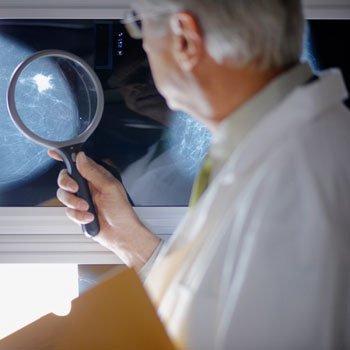Breast Alert: What Are the Advantages of 3D Mammography?

Breast cancer is the most common form of cancer in women, aside from skin cancer. About 40,000 women will die from it this year, and 232,670 women will be diagnosed with it, according to the American Cancer Society.
Twelve percent of women will develop invasive breast cancer at some point in their lives. If you’re a woman, there’s a 1 in 36 chance that breast cancer will be the cause of your death – a number second only to lung cancer.
The statistics are real and frightening. There is good news, however: With increased awareness, earlier detection and improved treatment, breast cancer death rates have declined since 1989, and this trend continues with significant advances in science and technology.
In fact, research shows that 3D mammography, one of the newest and most promising developments in screening and detection, is making an incredible difference in breast cancer detection – increasing detection rates by as much as 50 percent.
What is a 3D Mammogram?
3D mammography, or breast tomosynthesis, provides three-dimensional images of the breast. It provides a clearer, more accurate view of the breast tissue and allows doctors to better pinpoint the size, shape and location of abnormalities.
For 3D mammography, an X-ray machine moves across the breast in an arc, taking multiple pictures that a computer then translates into a multi-dimensional image. The X-ray images are taken in one-millimeter slices, providing radiologists unprecedented clarity of tissue details because they can look at the breast one “slice” at a time.
3D mammograms use very low amounts of radiation, but because they are generally performed at the same time as standard 2D flat-image mammograms, the low-dose radiation is slightly higher that when 2D mammograms are performed alone.
They are considered safe, though, and the Food and Drug Administration approved tomosynthesis last year, confirming that radiation levels are less than FDA-allowed limits. 3D mammography is currently being used in 46 states.
3D mammography only takes about four seconds and can make all the difference in the world when it comes to detecting breast cancer, and consequently, changing and improving the lives of women.
Increased Cancer Detection
Studies show that 3D mammography is significantly more effective for breast cancer detection.
With this new technology, doctors are able to examine breast tissue layer by layer. The detail shown from three-dimensional imagery allows them to detect tumors as small as two and three millimeters, which can reduce the amount of treatment patients could need.
Doctors and researchers have found the best results by combining both current and new technologies. The complexity of breast tissue can be difficult to analyze fully with only two-dimensional images. Because of this, 3D mammography can be particularly effective for women with dense breast tissue.
Integrating 3D mammography with standard 2D mammograms has been shown to increase overall cancer detection rates by as much as 30 percent and invasive cancer detection up to 50 percent.
Not only that, but doctors’ ability to determine accurately whether a tumor is benign or cancerous also improves with these super-detailed images.
Earlier Detection for Better Treatment
Early detection is the best defense against breast cancer – much like most other cancers. This is why routine mammograms are strongly encouraged, especially for those women with family history and increased risk.
Because of the ability to show minuscule detail like never before, 3D mammography allows doctors to diagnose breast cancer more accurately and earlier, when it’s most treatable. Tumors as small as two and three millimeters can be detected, giving woman a better chance of beating the odds and increasing survival rates.
This year alone, about 62,570 new cases of carcinoma in situ – the noninvasive, earliest form of breast cancer – will be diagnosed. Diagnosing cancers in their early stages allows patients and doctors to treat and beat breast cancer before it is too late or too developed, leading to a more promising outlook for women who have been either diagnosed or at risk.
Decreased False Recall Rates
One of the most stressful parts of getting a mammogram is having to return for more testing when initial readings are unclear or inconclusive. Because of the layer-by-layer scan and more detailed images, 3D mammography can offer women increased peace of mind.
Nearly 40 million mammograms are performed each year (most of them 2D mammograms), and about 4 million women are called back for additional exams. Of these recalls, more than 1 million minimally invasive biopsies are performed for further testing.
3D mammography improves radiologists’ accuracy and lessens false “call-back” recall rates by up to 40 percent, in addition to increased and earlier detection of breast cancer. Radiologists can reduce their patient recall rates more confidently, minimizing the anxiety women feel when asked to return.
Risks Associated with 3D Mammography
Because 3D mammography is relatively new, studies continue to be performed, but initial results appear promising. And although the FDA has approved 3D mammograms, some are concerned with the risk of increased radiation exposure.
Radiation is a known cause of cancer, and an analysis performed in 2009 estimated that medical imaging, or CT scans, caused approximately 29,000 instances of cancer and 14,500 deaths a year.
So why would anyone voluntarily opt to increase radiation during a mammogram by undergoing 3D mammography? The answer researchers are hoping plays out is that women actually decrease their total radiation because less repeat testing and scanning is needed over time.
Should You Get a 3D Mammogram?
As with any medical issue, it’s important to discuss your options with your doctor.
Because the tests are new, some insurance companies may not cover 3D mammography, so you may have to pay out of pocket. The increased peace of mind and accuracy, especially if you have a family history of breast cancer, may make the 3D mammography a smart option for you.

